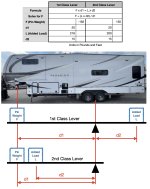I enjoy the systems side of RVing as much as I like the lifestyle (I love anything with wheels and a motor too). Anyhow, I’m not sure if this is widely known but there is a very basic calculation that can give you a really good idea of how much additional weight is transferred to the pin when you add weight to your rig. This is a basic calculation. Center of gravity, height of frame of the trailer, if you are running nose up (reduces weight transfer), nose down (increases weight transfer) or level, etc., all come into play.
You need to know these few basic things:
Wheelbase: Distance from the kingpin to the forwardmost axle.
Weight: The weight of the items you are adding
Weight Placement: The distance from the forwardmost axle to the center of the mass (stuff you are loading)
Overall length of the trailer: we’ll call it 38 feet for the 340RL
Here is the formula and it is called the “Lever Arm Formula”
Weight Transfer = (added weight x distance from wheelbase) / overall length of trailer
So if we add 1500 pounds of stuff (mass) 14 feet in front of the forwardmost rear axle (approximate distance from the axle to the garage) here is what it looks like.
(1500 x14) / 38 which calculates to 21000/38 = 552.68 (pounds of weight transfer to the pin for the added 1500 pounds)
Now let’s look at adding a washer and dryer and presume that in combination the washer and dryer are 400 pounds in aggregate. Those are placed, hypothetically, 24 feet in front of the forwardmost rear axle.
(400 x24) / 38 which calculates to 9600/38 = 252 pounds of weight transfer.
So the further forward the mass is in relation to the rear wheel the greater the percentage of weight transfer to the pin in this model.
Weight behind the forwardmost axle reduces the weight transfer. If you add weight behind the forward most axle, you can use the same formula but make the distance to the rear axle a negative number. Weight transfer from below the frame is calculated differently. Weight transfer in a bumper pull is calculated differently.
In a simple environment, lever, fulcrum, weight, this is highly reliable. In an RV it is a good ballpark estimate.
You need to know these few basic things:
Wheelbase: Distance from the kingpin to the forwardmost axle.
Weight: The weight of the items you are adding
Weight Placement: The distance from the forwardmost axle to the center of the mass (stuff you are loading)
Overall length of the trailer: we’ll call it 38 feet for the 340RL
Here is the formula and it is called the “Lever Arm Formula”
Weight Transfer = (added weight x distance from wheelbase) / overall length of trailer
So if we add 1500 pounds of stuff (mass) 14 feet in front of the forwardmost rear axle (approximate distance from the axle to the garage) here is what it looks like.
(1500 x14) / 38 which calculates to 21000/38 = 552.68 (pounds of weight transfer to the pin for the added 1500 pounds)
Now let’s look at adding a washer and dryer and presume that in combination the washer and dryer are 400 pounds in aggregate. Those are placed, hypothetically, 24 feet in front of the forwardmost rear axle.
(400 x24) / 38 which calculates to 9600/38 = 252 pounds of weight transfer.
So the further forward the mass is in relation to the rear wheel the greater the percentage of weight transfer to the pin in this model.
Weight behind the forwardmost axle reduces the weight transfer. If you add weight behind the forward most axle, you can use the same formula but make the distance to the rear axle a negative number. Weight transfer from below the frame is calculated differently. Weight transfer in a bumper pull is calculated differently.
In a simple environment, lever, fulcrum, weight, this is highly reliable. In an RV it is a good ballpark estimate.


